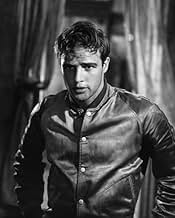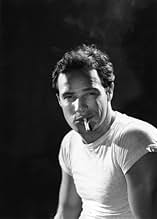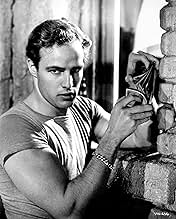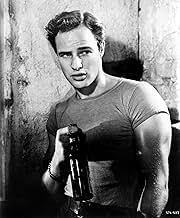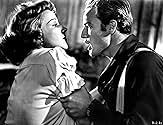La afligida Blanche DuBois se muda con su hermana a Nueva Orleans y se ve atormentada por su brutal cuñado mientras la realidad se desmorona a su alrededor.La afligida Blanche DuBois se muda con su hermana a Nueva Orleans y se ve atormentada por su brutal cuñado mientras la realidad se desmorona a su alrededor.La afligida Blanche DuBois se muda con su hermana a Nueva Orleans y se ve atormentada por su brutal cuñado mientras la realidad se desmorona a su alrededor.
- Ganó 4 premios Óscar
- 22 premios ganados y 15 nominaciones en total
James Adamson
- Extra
- (sin créditos)
Irene Allen
- Extra
- (sin créditos)
Mel Archer
- Foreman
- (sin créditos)
Walter Bacon
- Club Patron
- (sin créditos)
Dahn Ben Amotz
- Minor Role
- (sin créditos)
Opiniones destacadas
A dramatic and disturbing film based on Tennessee Williams's play . It deals with the tarnished Blanche DuBois (Vivien Leigh is unforgettable as a fading southern belle) who moves to live in New Orleans with her sister, Stella (Kim Hunter) , but there things go wrong when she meets her brutish , heavy-drinking brother-in-law, Stanley Kowalski (a sweaty , animalistic Marlon Brando , a role who shot him to superstardom) in his rattrap New Orleand apartment . As Blanche is a sexually disturbed woman who lives in a world of illusion . Her world starts to crumble when she moves in with her sister, as circumstances become unbearable when rumors of Blanche's dark past begin knowing among neighbors and then the happenings go awry ...When she got there she met the brute Stan, and the side of New Orleans she hardly knew existed. The Pulitzer Price Play of New Orleans' Latin Quarter...of a Lonely Girl...of Emotions Gone Savage!... Blanche, who wanted so much to stay a lady... Warner Bros. Bring the screen all the fire of A Streetcar Named Desire.
Well-deserved Academy Awards were garnered by Vivien Leigh as main actress , while Kim Hunter and Karl Malden won as secondary actors, providing all of them terrific and hypnotic qualities on their extraordinary interpretations . The excellent production design is first-rate , being competently set in the French Quarter of New Orleans during the restless years following World War Two . Main and support cast are frankly magnificent delivering excellent interpretation. Vivien Leigh is awesome as a fragile and neurotic woman who has suffered a series of calamities in her thunderous life . Marlon Brando gives a terrific acting as the abusive ,sinewy , brutish brother-in-law who believes to live under Louisiana's Napoleonic code what belongs to the wife belongs to the husband. They're very well accompanied by a great support cast , such as : Kim Hunter , Karl Malden , Rudy Bond and Nick Dennis. However , one reservation , all the roles are just fairly unbelieable and really exaggerated with the exception for Kim Hunter.
The motion picture was stunningly directed by Elia Kazan and considered to be one of the best films of the year , as he said it was one of his favorites of all the movies he made . Although gloomy and sordid throughout A Streetcar Named Desire fascinates rather than alienates the audience , thanks to the unpredictability of the play and riveting art decoration and set decoration that were both also rewarded with Academy Awards. During his long career, Kazan won two Oscars as Best Director and received an Honorary Oscar, won three Tony Awards, and four Golden Globe Awards. Kazan directed four performers to Best Actress Oscars: Celeste Holm, Kim Hunter, Eva Marie Saint and Jo Van Fleet. Greek-Turkish director Elia Kazan who being a child emigrated along with his family to United States made magnificent films . Some of them describe memories , emotions and infancy images , narrating the persecution to Greeks and Armenians by Turkish that finished in genocide as in ¨America , America¨ . Kazan directed a string of successful films as ¨Gentleman's agreement¨, ¨Man on a tightrope¨, ¨panic in the streets¨, ¨Pinky¨ , ¨Splendor in the grass¨, ¨Baby doll¨, ¨the engagement¨, ¨a Street named desire¨, ¨East of Eden¨ and especially his greatest hit : ¨On the waterfront¨ , the latter includes biographic elements ; in fact, Kazan worked in this waterfront area in 1934 during the height of the Great Depression .
There are other versions , but roughly inferior , based on the classic play by Tennessee Williams titled ¨A Streetcar Named Desire¨ , such as : 1984 by John Erman Ann-Margret as Blanche DuBois , Treat Williams as Stanley Kowalski and Beverly D'Angelo as Stella DuBois Kowalski. And 1995 rendition by Glenn Jordan with Jessica Lange , Alec Baldwin , Diane Lane , Randy Quaid and John Goodman.
Well-deserved Academy Awards were garnered by Vivien Leigh as main actress , while Kim Hunter and Karl Malden won as secondary actors, providing all of them terrific and hypnotic qualities on their extraordinary interpretations . The excellent production design is first-rate , being competently set in the French Quarter of New Orleans during the restless years following World War Two . Main and support cast are frankly magnificent delivering excellent interpretation. Vivien Leigh is awesome as a fragile and neurotic woman who has suffered a series of calamities in her thunderous life . Marlon Brando gives a terrific acting as the abusive ,sinewy , brutish brother-in-law who believes to live under Louisiana's Napoleonic code what belongs to the wife belongs to the husband. They're very well accompanied by a great support cast , such as : Kim Hunter , Karl Malden , Rudy Bond and Nick Dennis. However , one reservation , all the roles are just fairly unbelieable and really exaggerated with the exception for Kim Hunter.
The motion picture was stunningly directed by Elia Kazan and considered to be one of the best films of the year , as he said it was one of his favorites of all the movies he made . Although gloomy and sordid throughout A Streetcar Named Desire fascinates rather than alienates the audience , thanks to the unpredictability of the play and riveting art decoration and set decoration that were both also rewarded with Academy Awards. During his long career, Kazan won two Oscars as Best Director and received an Honorary Oscar, won three Tony Awards, and four Golden Globe Awards. Kazan directed four performers to Best Actress Oscars: Celeste Holm, Kim Hunter, Eva Marie Saint and Jo Van Fleet. Greek-Turkish director Elia Kazan who being a child emigrated along with his family to United States made magnificent films . Some of them describe memories , emotions and infancy images , narrating the persecution to Greeks and Armenians by Turkish that finished in genocide as in ¨America , America¨ . Kazan directed a string of successful films as ¨Gentleman's agreement¨, ¨Man on a tightrope¨, ¨panic in the streets¨, ¨Pinky¨ , ¨Splendor in the grass¨, ¨Baby doll¨, ¨the engagement¨, ¨a Street named desire¨, ¨East of Eden¨ and especially his greatest hit : ¨On the waterfront¨ , the latter includes biographic elements ; in fact, Kazan worked in this waterfront area in 1934 during the height of the Great Depression .
There are other versions , but roughly inferior , based on the classic play by Tennessee Williams titled ¨A Streetcar Named Desire¨ , such as : 1984 by John Erman Ann-Margret as Blanche DuBois , Treat Williams as Stanley Kowalski and Beverly D'Angelo as Stella DuBois Kowalski. And 1995 rendition by Glenn Jordan with Jessica Lange , Alec Baldwin , Diane Lane , Randy Quaid and John Goodman.
Blanche DuBois reminds me of Norma Desmond in Sunset Blvd. (1950). Both characters succumb to their alter egos, and descend into their own worlds of fantasy and half-truths.
In "A Streetcar Named Desire", Blanche travels from her antebellum roots in Mississippi to New Orleans, to see her sister Stella. But, upon arriving in the Big Easy, Blanche must confront Stella's husband Stanley, a greasy, poker-playing neanderthal lout who knows a thing or two about reality. It's the clash between Blanche's stately delusions and Stanley's gritty realism that soups up the drama in this Tennessee Williams play, converted to film classic by director Elia Kazan.
The drama is absorbing. But the performances of Marlon Brando and Vivien Leigh, as Stanley and Blanche, are what make the film the cinematic powerhouse that it is. Excellent B&W lighting and jazzy background music amplify the seedy, sleazy atmosphere, which adds depth and texture to the story and the acting. And, of course, the claustrophobic, steamy French Quarter makes a perfect setting.
As one would expect for a film derived from a play, "A Streetcar Named Desire" is very talky. Generally, I don't care for films burdened with a ten thousand page script. But this talk-fest is an exception. Overwhelming what I would otherwise consider a weakness, the acting of Brando and Leigh alone are enough to justify a two hour investment, and render an enjoyable and memorable cinematic experience.
In "A Streetcar Named Desire", Blanche travels from her antebellum roots in Mississippi to New Orleans, to see her sister Stella. But, upon arriving in the Big Easy, Blanche must confront Stella's husband Stanley, a greasy, poker-playing neanderthal lout who knows a thing or two about reality. It's the clash between Blanche's stately delusions and Stanley's gritty realism that soups up the drama in this Tennessee Williams play, converted to film classic by director Elia Kazan.
The drama is absorbing. But the performances of Marlon Brando and Vivien Leigh, as Stanley and Blanche, are what make the film the cinematic powerhouse that it is. Excellent B&W lighting and jazzy background music amplify the seedy, sleazy atmosphere, which adds depth and texture to the story and the acting. And, of course, the claustrophobic, steamy French Quarter makes a perfect setting.
As one would expect for a film derived from a play, "A Streetcar Named Desire" is very talky. Generally, I don't care for films burdened with a ten thousand page script. But this talk-fest is an exception. Overwhelming what I would otherwise consider a weakness, the acting of Brando and Leigh alone are enough to justify a two hour investment, and render an enjoyable and memorable cinematic experience.
10Rathko
There is little to be said about this movie that thousands of critics have not stated already. It is a magnificent piece of cinema, with an intricate script delivered by actors at the peak of their talents. Leigh is unbearably brittle and fragile and she dances precariously on the edge of sanity. Marlon Brando embodies a sense of brooding masculinity that other men can only dream of attaining, while creating an enduring cinema icon and delivering one of the all-time great movie lines. From the raucous jazz score to the sleazy production design bathed in smoldering grey, 'Streetcar' is a class-act from beginning to end; sexy, brutal, and endlessly fascinating.
Now that this filmization of "Streetcar" is over a half century old, it can be looked at in a more objective manner than that of the early fifties. The "classical/traditional" acting style of Vivien Leigh, which was placed in stark contrast to the rest of the production personnel, continues to hold its own brilliantly.
It's probably hard today for some to imagine the strong opposition Leigh's casting faced back in 1950, when this prim actress from England was chosen (mostly by studio chief Jack Warner) over "method" Broadway actress Jessica Tandy.
A goodly number of cast and production people from the hit play directed by Elia Kazan were engaged by the director for the film version, and they were not at all enthusiastic about risking a "clash" of acting styles in the leading, pivotal role of Blanche. Kazan himself was reportedly very pro-Tandy, and quite disappointed in the studio's decision.
Yet, Warner and his staff felt Tandy wasn't that well known to the general movie going public--especially in contrast to Leigh, whose marquee name was by then almost magical. In recent interviews, Kazan admitted that working with Vivien was "a real challenge."
In looking at the film today, however, it's Leigh who emerges as a genuine "star" of this production. True, her facial expressions, vocal inflections and body gestures may be the result of careful, deliberate planning, but so what? It's also the aspect that commands attention and draws the viewer to her portion of the screen throughout this film.
Her southern accent, so well learned and retained from her work as Scarlett in "GWTW," is convincing and very beautiful to hear. It also fits Blanche perfectly, as does Leigh's stylized "choreography," which was undoubtedly retained from her long-running London stage performance.
Not all the combined, formidable talents of "method" giants as Karl Malden, Kim Hunter, Marlon Brando or Kazan can diminish the hypnotic work of Leigh here. It may not have excited "Gadge" Kazan, but it remains a highlight performance in film history (and impressed the Academy enough to bestow an "Oscar" to Vivien.)
It also didn't hurt to have Alex North's pungent score, which remains this composer's finest hour.
It's probably hard today for some to imagine the strong opposition Leigh's casting faced back in 1950, when this prim actress from England was chosen (mostly by studio chief Jack Warner) over "method" Broadway actress Jessica Tandy.
A goodly number of cast and production people from the hit play directed by Elia Kazan were engaged by the director for the film version, and they were not at all enthusiastic about risking a "clash" of acting styles in the leading, pivotal role of Blanche. Kazan himself was reportedly very pro-Tandy, and quite disappointed in the studio's decision.
Yet, Warner and his staff felt Tandy wasn't that well known to the general movie going public--especially in contrast to Leigh, whose marquee name was by then almost magical. In recent interviews, Kazan admitted that working with Vivien was "a real challenge."
In looking at the film today, however, it's Leigh who emerges as a genuine "star" of this production. True, her facial expressions, vocal inflections and body gestures may be the result of careful, deliberate planning, but so what? It's also the aspect that commands attention and draws the viewer to her portion of the screen throughout this film.
Her southern accent, so well learned and retained from her work as Scarlett in "GWTW," is convincing and very beautiful to hear. It also fits Blanche perfectly, as does Leigh's stylized "choreography," which was undoubtedly retained from her long-running London stage performance.
Not all the combined, formidable talents of "method" giants as Karl Malden, Kim Hunter, Marlon Brando or Kazan can diminish the hypnotic work of Leigh here. It may not have excited "Gadge" Kazan, but it remains a highlight performance in film history (and impressed the Academy enough to bestow an "Oscar" to Vivien.)
It also didn't hurt to have Alex North's pungent score, which remains this composer's finest hour.
Blanche Dubois arrives in the French Quarter of New Orleans suffering from a mental tiredness brought on by a series of financial problems that have ended in the family losing their plantation. She has come to stay with her sister, Stella and her husband Stanley Kowalski in their serviceable little apartment. The aggressive and animalistic Stanley immediately marks himself as the opposite of the feminine and refined Blanche and Stella finds herself pulled between the two of them. Stanley suspects all is not as it seems and begins to pry into Blanche's colourful past, even as Blanche spots a way out in the arms of the Mitch, a man captivated by her. However it doesn't take long before the cracks begin to show in the relationships and in Blanche herself.
It almost goes without saying that the writing here is of top-notch quality. The story is a relatively simple character piece that can be summed up in a couple of sentences, however this would do a great injustice to the depth of development and the convincing manner in which the characters are all written and the story told. It is not so much the depth that some of the characters go to, but the complexity that is effortlessly written into them we can see it writ large on them, but not to the point where it seems obvious or uninteresting. Blanche is of course the focus and she is a mess of neurosis barely hidden behind a front of respectability that clearly doesn't convince her anymore than it does Stanley. Mitch is also really well written at first it is comic that he tries to be such a gentleman while having the brute just under the surface, but later his frustration is heavy on his face along with his anger. The overall story is surprisingly, well, "seedy" is the best word that comes to mind. It is in the gutter and no matter what Blanche wants to believe, that is where it stays and the film is right there the whole time.
How Kazan managed it in the early fifties is beyond me, because even now the film is pretty graphic in its violence to women, subject matter and rippling sexuality across pictures and characters. It is a compelling story due to the characters and the manner in which they are delivered Kazan's atmospheric direction really helps; the films feels humid and close, and he has done it all with a basic set and a camera. The lighting throughout is wonderful both in the general atmosphere but also specific touches such as the way Blanche manages to visibly age due to lighting changes when the film has slight chances of tone.
Of course the main reason I keep coming back to this wonderful film is the actors, who take the opportunity and, in many cases, make it so that it is hard to see anyone else playing their roles. Leigh is perfect for the role and gets everything absolutely spot on; she is vulnerable yet self-seeking, confident yet needy, proper yet unstable. Even visually Leigh is convincing in terms of body language but also the fact that she looks the right mix of ages, looking beautiful one moment but worn and defeated the next totally, totally deserved her Oscar. Brando made his name here and even now his performance is electrifying and memorable. He has his big scenes where he gets to play to the back row but he also has moments where he does nothing other than be a presence on screen; no matter what is going on we are watching him because we are as in awe and yet as afraid of his power as Blanche is herself. Together Leigh and Brando dominate the screen and whenever either of them are on screen it is hard to look away. As a result, Kim Hunter sort of gets lost in the background although her performance is still good. Karl Madden is great but again only holds a supporting role and deserved his Oscar for a convincing performance of a well-written character. Of course it is easier to give good performances with great material than with bad material but there have been enough versions of this play around for us to see how lesser actors can fail where this cast soared.
Overall this is a great film that sees so many critical aspects all coming together as one final product. A superb play has undergone a great adaptation that has been seized upon a great cast who deliver a collection of performances that deserve all the praise heaped on them, all directed with a real sense of atmosphere that really delivers a seedy and erotic film both for its time and today. I cannot think of an excuse for people not having seen this film.
It almost goes without saying that the writing here is of top-notch quality. The story is a relatively simple character piece that can be summed up in a couple of sentences, however this would do a great injustice to the depth of development and the convincing manner in which the characters are all written and the story told. It is not so much the depth that some of the characters go to, but the complexity that is effortlessly written into them we can see it writ large on them, but not to the point where it seems obvious or uninteresting. Blanche is of course the focus and she is a mess of neurosis barely hidden behind a front of respectability that clearly doesn't convince her anymore than it does Stanley. Mitch is also really well written at first it is comic that he tries to be such a gentleman while having the brute just under the surface, but later his frustration is heavy on his face along with his anger. The overall story is surprisingly, well, "seedy" is the best word that comes to mind. It is in the gutter and no matter what Blanche wants to believe, that is where it stays and the film is right there the whole time.
How Kazan managed it in the early fifties is beyond me, because even now the film is pretty graphic in its violence to women, subject matter and rippling sexuality across pictures and characters. It is a compelling story due to the characters and the manner in which they are delivered Kazan's atmospheric direction really helps; the films feels humid and close, and he has done it all with a basic set and a camera. The lighting throughout is wonderful both in the general atmosphere but also specific touches such as the way Blanche manages to visibly age due to lighting changes when the film has slight chances of tone.
Of course the main reason I keep coming back to this wonderful film is the actors, who take the opportunity and, in many cases, make it so that it is hard to see anyone else playing their roles. Leigh is perfect for the role and gets everything absolutely spot on; she is vulnerable yet self-seeking, confident yet needy, proper yet unstable. Even visually Leigh is convincing in terms of body language but also the fact that she looks the right mix of ages, looking beautiful one moment but worn and defeated the next totally, totally deserved her Oscar. Brando made his name here and even now his performance is electrifying and memorable. He has his big scenes where he gets to play to the back row but he also has moments where he does nothing other than be a presence on screen; no matter what is going on we are watching him because we are as in awe and yet as afraid of his power as Blanche is herself. Together Leigh and Brando dominate the screen and whenever either of them are on screen it is hard to look away. As a result, Kim Hunter sort of gets lost in the background although her performance is still good. Karl Madden is great but again only holds a supporting role and deserved his Oscar for a convincing performance of a well-written character. Of course it is easier to give good performances with great material than with bad material but there have been enough versions of this play around for us to see how lesser actors can fail where this cast soared.
Overall this is a great film that sees so many critical aspects all coming together as one final product. A superb play has undergone a great adaptation that has been seized upon a great cast who deliver a collection of performances that deserve all the praise heaped on them, all directed with a real sense of atmosphere that really delivers a seedy and erotic film both for its time and today. I cannot think of an excuse for people not having seen this film.
¿Sabías que…?
- TriviaAs the film progresses, the set of the Kowalski apartment actually gets smaller to heighten the suggestion of Blanche's increasing claustrophobia.
- ErroresWhen Stanley comes back from taking Stella to the hospital, he is looking for a bottle opener. He finds it on the mantelpiece, shakes up a bottle of beer, and opens it. The beer foams up and spills on his trousers. But if you watch at the moment when he swings himself up to sit on the table - before he opens the bottle - you can see that the front of his trousers are already wet. Apparently they re-shot it without him changing into dry trousers.
- Versiones alternativasThe scene in which Blanche and Stanley first meet was edited a bit to take out some of the sexual tension that both had towards each other when the film was first released in 1951. In 1993, this footage was restored in the "Original Director's Version" of the film. The three minutes of newly-added footage sticks out from the rest of the film because Warner Brothers did not bother to restore these extra film elements along with the rest of the movie, leaving them very scratchy due to deterioration.
- ConexionesEdited into Un Américain nommé Kazan (2018)
- Bandas sonorasIt's Only a Paper Moon
(1933) (uncredited)
Music by Harold Arlen
Lyrics by E.Y. Harburg and Billy Rose
Sung by Vivien Leigh while doing her hair
Selecciones populares
Inicia sesión para calificar y agrega a la lista de videos para obtener recomendaciones personalizadas
Detalles
- Fecha de lanzamiento
- País de origen
- Idiomas
- También se conoce como
- A Streetcar Named Desire
- Locaciones de filmación
- Nueva Orleans, Luisiana, Estados Unidos(railway station)
- Productoras
- Ver más créditos de la compañía en IMDbPro
Taquilla
- Presupuesto
- USD 1,800,000 (estimado)
- Total a nivel mundial
- USD 54,695
- Tiempo de ejecución2 horas 2 minutos
- Color
- Relación de aspecto
- 1.37 : 1
Contribuir a esta página
Sugiere una edición o agrega el contenido que falta







